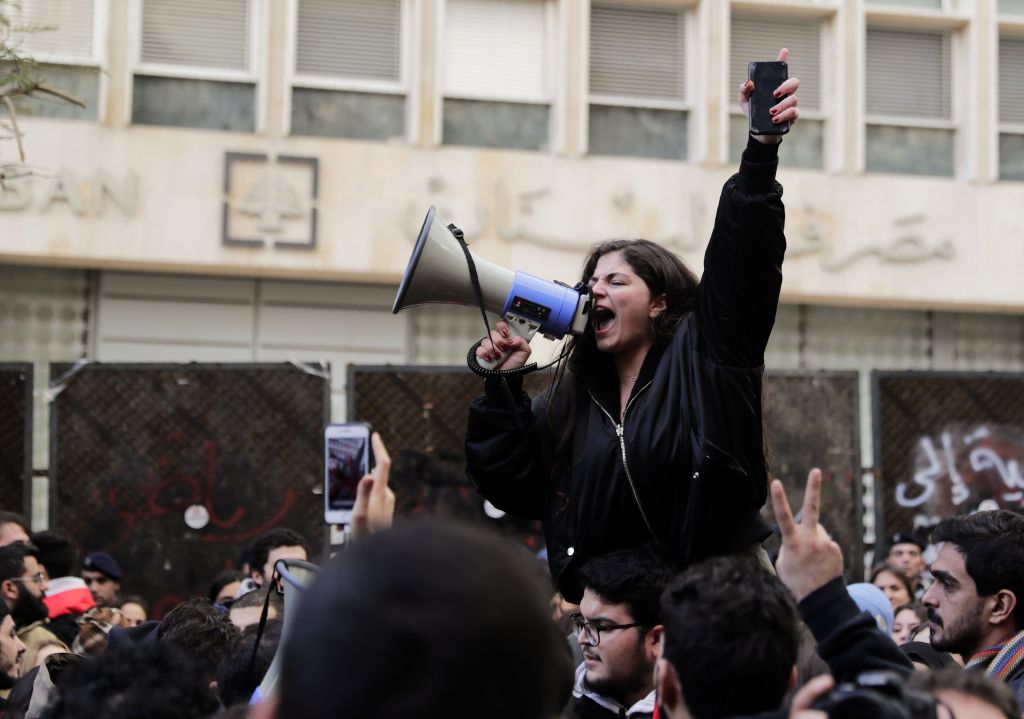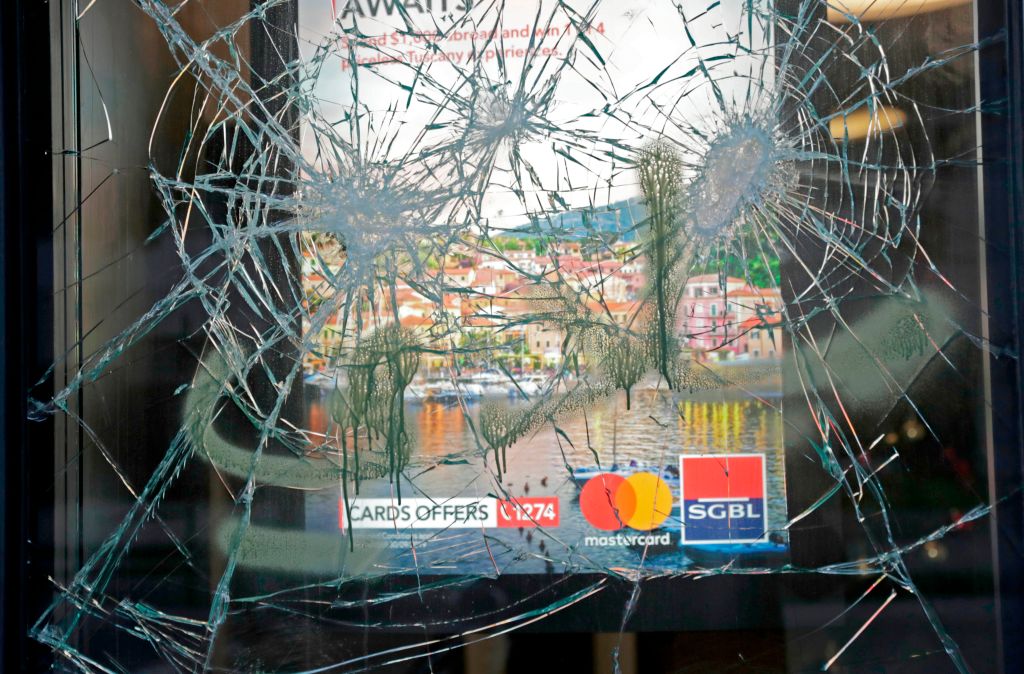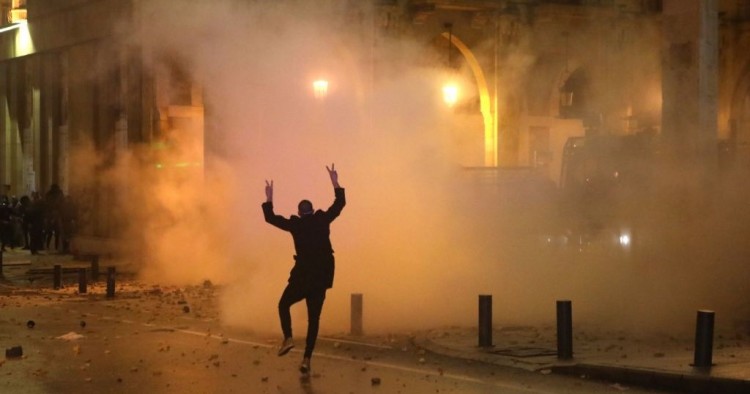The sky’s sliding in Lebanon. It’s been sliding for years. Since securing a new era of independence in 2005, Lebanese leaders and their factions have been unwilling and/or unable to confront overlapping fiscal, monetary, and economic challenges — let alone operate with good faith in political system and constitutional order that, being built for and around elite bargaining, make it all worse when elites bicker and feud.
The Lebanese have managed to sneak through 2019, or most of 2019, without a complete collapse, avoiding a catastrophe like those seen in Argentina, Venezuela, Thailand, and other states over the past 30 years. But they did so by desecrating the holy trinity — a currency peg, high-reward policy, and free flow of money — they’d worshiped throughout that time. And they’ve turned creeping challenges into acute crises, which reflect and reinforce deeper structural problems. Ringing in the new year, the Lebanese may soon face the real reckoning that they’ve thus far avoided. Having bought time they’ve increasingly needed with money they’ve increasingly lacked, but somehow conjured, they’re running out of magic and running out of money.
While Lebanese leaders still have some space and time to avoid today’s worst-case scenarios, which are worse than yesterday’s worst-case scenarios, they’ve thus far never stopped squabbling long enough to stop squandering their chances to change something — anything! — about the way they, and Lebanon, operate. Even now, after hundreds of thousands of people have spent three months protesting peacefully around the country, Lebanese leaders have done nothing but sacrifice the corpse of a cabinet they took nine years to conceive, nine months to birth, six months to strangle, and two weeks to resurrect, kill again, and finally bury. Unless and until Lebanese leaders drastically change their behavior, or Lebanese citizens change their leaders — and, above all, the types of people they see as leaders — they risk repeating the mistakes of the past. And they will thus contribute to crises in the short run while making worse the longer-term challenges and problems that they’ve left as a legacy to their people in this “new” era of independence.
***
On March 14, 2005, more than a million people marched in — and into — Beirut. Demanding change, they transformed a city destroyed once by war and again by reconstruction into the pulsing heart of a country it was always meant to be. It was a magical moment: a concert of communities, an apex of the Lebanese way, the end of an era. But the Lebanese had different demands, different reasons for making demands, different points of reference and framing, and different deeper sentiments — hopes and fears, desires and needs — shaping their behavior. And they looked to different leaders: the eternal “forest of fathers” — or, forest of factions — who were breaking into loyalist and opposition groups that maneuvered, respectively, to uphold or upend the occupation order.
The Lebanese who participated in the Cedar Revolution succeeded because, in part, established leaders formed an effective counter-elite — or counter-consensus elite — to harness discontent, practice politics, and secure and sustain international, regional, and domestic support for a specific goal: “Syria Out.” They succeeded — perversely, though many knew it even then — while sowing the seeds of subsequent failures. They did not overthrow the little lords that have — in one way or another, in one guise or another — governed the area of Lebanon for generations. They did not overthrow themselves, achieving the most difficult and deepest dimension of any “Revolution”: to transcend, or at least otherwise overcome, the obstacles within.
After eating their breakfast of hope, the Lebanese dined on disappointment. In a “new” independence era that has now lasted as long as the Lebanese Civil War (1975-1990) and occupation(s) order (1990-2005), they’ve struggled through wars, battles, skirmishes, and bloodlettings; assassinations, terrorist attacks, and covert campaigns; constitutional crises, political paralysis, and institutional vacuums; and corruption, excess, inefficiency, and ineptitude. A half-dozen men have ruled, sitting atop the order as they did before the Cedar Revolution. Lesser leaders — regional bosses, local strongmen, clerics, and careerist creatures installed as sycophantic advisors and middle managers — retain far more influence in practice than they have on paper. Institutional officials — in civilian bureaucracies, security services, and technical institutions — enjoy influence that is a function, perversely enough, of elite convergence (providing political cover), elite competition (creating gaps in which others, be they generals, chieftains, or central bank governors, may operate), and elite ignorance or disinterest (which allows sub-ministerial cabals to skew policy and practice, even when policies and practices exist). Everyone else orbits around these different Suns — and their sons, and their sons, and their sons, who rise like literal, functional, and/or spiritual successors in the system. Jostling within and between communities, which are semi-voluntary associations that lend Lebanon its twisted Tocquevillian pluralism, Lebanese factions have made the state their instrument, vessel, and hostage. They’ve also made the state into a business, which they’ve basically busted out. Instead of providing public goods for the wider community, they use the state to make, take, and spend money; protect and promote factional interests, while incessantly undercutting other factions or, just as often, people just trying to do their jobs; and, to be sure, provide goods, benefits, and services for their cronies and constituents — substituting themselves for a state they’ve pillaged, while railing against realities they created during the occupation, its end, and in the era since.
***
Back in the 1990s, the Syrian regime and Lebanese leaders manipulated the post-conflict transition and reconstruction to suit their strategic and commercial interests — and did the same with fiscal, monetary, and macroeconomic policies. Always more adept at besieging towns or brutalizing dissidents, the Syrian regime couldn’t encourage entrepreneurs, attract international investors, or convince diaspora citizens to return to Lebanon. The currency collapsed. Businesses closed. Prices of goods and services skyrocketed. People protested and toppled the cabinet, threatening to undermine the Syrian regime’s still-nascent occupation. A bit reluctantly, the Syrians and Lebanese leaders agreed to the ascent of Rafik Hariri as premier. A billionaire who’d made his fortune in the Arab Gulf states, Hariri personified the postwar order — in all aspects, positive and negative — from 1992 to 2005. Hariri brought in Riad Salameh from Merrill Lynch to serve as Lebanon’s central bank governor.

Working with Beirut-based banks, Salameh and the central bank strengthened the lira and then (essentially) pegged it to the U.S. dollar. Meanwhile, Lebanese leaders in all spheres put on quite the performance. They milked ministries dry, then milked them some more. They created councils, parastate institutions, and companies. They used their influence in or control of state institutions to award contracts and otherwise create favorable business conditions for their friends. And Lebanese leaders maintained a currency peg, a free flow of money, and high interest rates on deposits — denominated in dollars and in lira — to encourage people to park their money in Beirut-based banks, which in turn funded the state, which Lebanese leaders in turn controlled and influenced.
Lebanon has been one of the most indebted states in the world, while almost always spending more than it’s made, since then. The Lebanese state has often spent money without budgets or proper plans — and never mind comprehensive, integrated strategies and overarching visions. It now bleeds billions — about $6 billion a year, or more if counting overdue payments, interest, and underreported spending. What’s worse, the state hasn’t spent productively. It now dedicates 75 percent of spending — not revenues or some combination of revenues and reserves, but all spending — to salaries and benefits, debt servicing, and subsidies. (In some years, it spends as little as one percent productively.) The state spends in ways that overlap, directly and indirectly, compounding benefits for specific people while compounding costs and consequences for all of Lebanon. In a given sector, the state may spend to employ people it does not need, who in turn don’t do the jobs they’re not qualified for and shouldn’t have in the first place; pay for necessary, but expensive and inefficient inputs, processes, services, and/or facilities; cover losses, which include technical losses due to inefficient infrastructure and/or poor practice, “non-technical” losses due to factionalism and clientelism, and “redirected” revenues due to corruption; and/or finance the favored schemes and arrangements of incumbent ministers and parties — at a premium! — only to abandon them for new schemes and arrangements once parties switch or share portfolios.
Over time, Lebanese leaders and bankers have borrowed and schemed to spend through the state, manage the consequences of the past (say, reconstruction), and/or cope with crises (“events” like assassinations, the July 2006 War, the 2008 May clashes, and the Syrian war of 2011, but also their own feuding and fighting). Then, they’ve borrowed and schemed more to cope with the consequences of prior borrowing and scheming. Borrowing about $20 billion for reconstruction, with debts due to the state’s control and mismanagement of the energy sector of at least $35 billion, they’ve also had to pay salaries, maintain subsidies, defend the peg, support imports directly and indirectly — while increasingly paying prior debts and bleeding money due to inefficiency, ineptitude, and corruption. It’s piled up: Lebanon’s debt-to-GDP ratio has soared as high as 180 percent, while now hovering at around 150 percent. (Other measures are bad, too, including the state’s debt-to-revenue ratio and different ratios that play around with the spending needs and available and/or possible pools of money.)
Lebanese leaders have done — or, by creating crises and paralyzing high institutions, compelled others to do — all of this through the state (the Republic of Lebanon, which may be represented by the “Government of Lebanon,” the “Ministry of Finance,” and so on) and financial institutions (the Lebanese Central Bank and Beirut-based banks). These entities have had to offer higher rewards when borrowing or scheming to offset risks, attract investors, and/or coax each other into participating in an increasingly intricate internal dance. As a borrower, the Republic of Lebanon has had to offer higher yields at home and abroad. As schemers (in a value-neutral sense), the Lebanese Central Bank and Beirut-based banks have had to offer high yields and engage in more creative or risky approaches to keep money in Lebanon, attract diaspora money to Lebanon, and secure other investments or deposits.
The Lebanese fretted during crises like the July War of 2006 and the conflict of May 2008, but managed to avoid collapse. Indeed, they bounced back — and right into a boom — after the 2008 Doha Accord, banner tourism years, and unusually high levels of diaspora remittances and returns after a worldwide recession. Even so, Lebanon really began to struggle — imperceptibly, but inexorably — in 2011. Not knowing what the world had in store for them, Hezbollah, Amal, and the Free Patriotic Movement toppled a national-unity government that they’d insisted on forming after losing (for the second successive time) parliamentary elections. A few months later, as the Syrian regime militarized the struggle over Syria, the Lebanese again gained some but lost more from war in their neighborhood. Grappling with the consequences of their own constitutional crises, and the stresses and strains of a ballooning population, the Lebanese lost access to overland trade routes, hinterland markets, and drive-in Arab tourists (hundreds of thousands of people, in good years). The Lebanese also began to lose or see declines in other “external financial flows,” like (net) remittances and certain real estate investments.
Five years later, when it was clear that the Lebanese were dealing with trends and not events, the Lebanese Central Bank began “financial engineering” and other initiatives. The state kept borrowing, too. Beirut-based banks, meanwhile, kept depositing money with the central bank, participating in schemes, loaning the state money, buying up Lebanon-issued debt, and offering their own depositors high interest rates. On the one hand, they stopped the sky from falling. On the other hand, however, they began generating profits for themselves — particularly problematic, given that they and prominent politicians are still part of an incestuous elite. On balance, because of long-range policies and successive schemes, Lebanese leaders and bankers contributed to constricting commercial activity and economic output — warping difficult, though not necessarily “flawed,” fundamentals more and increasing the costs and risks for future moves.

They tossed a cherry on top in late 2019. Trying to manage its depleting dollars, the central bank began rationing them to Beirut-banks, which in turn needed to meet different demands. The Lebanese suffered through cash crunches and trade-linked currency controversies. They started to trade their currency outside the peg — in parallel markets that included exchanges and businesspeople with access to dollars. Banks stopped supplying ATMs with dollars — requiring people to come into specific branches to obtain the hard currency they needed for imports, rent, and travel; they also imposed and prolonged waiting periods and account holds for currency conversion from liras into dollars. Toward the end of the summer, syndicates began to strike: for instance, gas stations owners displeased with the behavior of banks and fuel importers started intermittently closing. Against that backdrop, the central bank and Beirut-based banks made a play to attract dollars, buy time, and shore up confidence. They offered a special high-yield certificate of deposit for any investor who brought “new” dollars into Lebanon from abroad. If a person placed their dollars with a Beirut-based bank’s branch in Lebanon for three years, they could obtain anywhere from 11 percent to 15 percent cumulative interest — with some bank managers offering to tack on 10 percent upfront, in interest and in some instances as a credit toward the principal (base amount). The banks brought in billions of dollars, which in turn allowed the central bank to report a positive net flow of around $1.5 billion, maintain confidence just before relevant reporting periods, and — above all — increase the amount of available dollars for the future.
All the while, Lebanese leaders kept bickering and dithering. Having not held parliamentary elections in nine years, they orchestrated polls in 2018, consolidated to protect their position atop the system, and then took nine months to form a cabinet. Not done wasting time, they then rarely met, rarely took initiatives when they did meet, rarely stuck to the initiatives they took, and then stopped meeting altogether — after partisans of parties in the same government shot each other in the streets. Amid shortages, strikes, cash crunches, and fires and floods — with the Lebanese, ratings agencies, and the world watching — they did nothing but heap insult and indignity upon people already fed up with the Lebanon they’d all made. Failing to address any of these issues in a meaningful manner, Lebanese leaders passed another austerity measure: a so-called WhatsApp tax. Enraged by everything, people took to the streets on Oct. 17, 2019. With varying degrees of participation and effectiveness, they spent three months protesting peacefully. Lebanese leaders kept feuding, kept trying to exploit the opportunity created by the crisis, and/or kept failing to understand the challenges that people face. Over the past weekend, protestors and security services clashed in the capital — marking, perhaps, the next stage of another struggle in Lebanon. Only now, after all of that, have Lebanese leaders announced the formation of a government — again doing far too little, far too late, while Lebanon slides and slides toward another abyss.
***
Lebanon’s in trouble. If and to the extent some Lebanese have taken false comfort in their ingenuity, adaptability, and resilience, they now see that their leaders have left them a pyramid of problems built upon the idea — a truism, a false foundation — that things could be worse.
Now, those self-styled leaders have abdicated responsibility after clear, consistent, peaceful, and powerful demands from citizens who’ve long tolerated — even celebrated — their rule. They must act, soon, to avoid a complete catastrophe. And, whether avoiding or coping with collapse, the Lebanese must well and truly consider how to shape a better future.
A non-resident scholar at MEI, Anthony Elghossain is a lawyer and writer based in Beirut. He advises non-governmental organizations on strategy, planning, organizational development, and substantive issues. Anthony is writing his first book, They Came in Peace: American Adventures in the Levant, due out in early 2021. The opinions expressed in this article are his own.
Photo by PATRICK BAZ/AFP via Getty Images
The Middle East Institute (MEI) is an independent, non-partisan, non-for-profit, educational organization. It does not engage in advocacy and its scholars’ opinions are their own. MEI welcomes financial donations, but retains sole editorial control over its work and its publications reflect only the authors’ views. For a listing of MEI donors, please click here.













